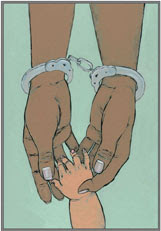One of the often hidden aspects of corrections are populations that do not conform to the public image of the American male offender. Our next panel, on special populations in prison, was designed to draw attention to these underserved populations and the special problems they face during and after incarceration.
The first speakers, Miss Major and Alexander Lee of the TGI Justice Project, spoke to the plight of transgendered prisoners. This plight is best understood through the general background provided by Miss Major on discrimination against the trans population. As she pointed out, the lack of opportunity to exist in a “normal” fashion, the rampant discrimination and ousting from schools, training, and workplaces, sometimes leads trans people to criminal activity. Another aspect of the etiology of trans incarceration is the criminalization of broad areas in trans people’s lives (incidentally: last year Hastings held a Transposium, which provided more background on transgender issues, and whose program can be found here). Lee expanded on the prison situation in particular: the assignation of prisoners to male and female institutions is done on the basis of genitalia, which leads many unoperated trans people to institutions that do not match their gender identity, and produces horrifying phenomena, ranging from rampant verbal harrassment to sexual assault. Lee also mentioned a few cases of what he called “sexual assault by proxy”, in which clients reported having been sent to problematic cells as fodder for violent, aggressive inmates, and being told by guards about this express purpose. The TGI justice project faces immense challenges in organizing prisoners, which it overcomes by producing a newsletter; there is a ray of hope, which lies in the inmates’ acquired high level of legal literacy and their awareness of their rights.
Our next speaker, Dr. Barbara Bloom of Sonoma State University, discussed the issue of women prisoners. The demographics of this population, which constituted 7% of the entire encarcerated population and 12% of the parolee population in 2007, differ from those of males in several important ways. Only about 30% of women are imprisoned for violent offenses; the vast majority are property and drug offenders. In terms of risk, less than 10% of them are considered Level IV prisoners, and almost 70% are Levels I and II. Most of them are in prison for parole violations. This led Bloom to ask whether this large low-risk population would need to be in prison at all, and would not be better served in a scheme of community-based corrections. The concern is particularly true in light of the fact that women prisoners are disporportionately women of color, poor, unemployed, and many of them are mothers of small children, survivors of sexual abuse, and with serious histories of substance abuse.
A big step in improving correctional policies for women was a 2004 report from the Little Hoover Foundation titled Breaking the Barriers for Women on Parole. The report, which recognized the lack of gender responsiveness in supervision, called for important changes in assessment and case management. Some of the highlights of the report, which later became official CDCR goals, included creating a comprehensive case management plan, creating alternatives to the overreliance on mega-prisons for women, and providing a continuum of housing and service options for transfering women seamlessly into the community. Some of these have been implemented: a training curriculum has been created, a special risk-and-needs assessment tool is in use, and some gender-responsive programs are in existence. However, women are still largely held in overcrowded facilities with no comprehensive continuum of care. There is much to be done particularly in the realm of alternative housing facilities.
Finally, Angie Junck of the Immigrant Legal Resource Center allowed us a peek into the hidden and disturbing world of correctional policies directed at foreign-born inmates. As it turns out, California prisons contain 30 percent of all noncitizen inmates in state prisons nationwide. Contrary to what some of us may have thought, many of these folks are not “illegal” or “undocumented”, but rather lawful permanent residents, or even naturalized citizens. Most of them come from Mexico, but there are many who hail from Central America and Asia.
The fate of these inmates is quite interesting. While they serve their sentence, the CDCR alerts immigration officials to the identity of anyone they believe to be a noncitizen; their mechanism for doing so is incredibly crude and relies on people’s last names. Immigration and customs enforcement officials then place a “hold” on the inmate, that is, a request that the prison or jail hold the pesron after their scheduled release time in order for immigration to assume custody and initiate deportation proceedings. At that point, they are transferred to the center for deportation, where the conditions are considerably worse than in California prisons. The hold itself has devastating effects on one’s prison experience: prisoners on hold are subject to higher security classification; according to data collected in 2000, their prison terms are, on average, 10 percent longer than those of comparable inmates. They cannot be paroled or released, are disqualified from rehabilitative prison programs, and are often located in a facility far away from home, presumably under the assumption that one does not have family and therefore does not need to be close to visitors. Information collected by the California Coalition regarding women immigrants revealed big difficulties in obtaining medical care due to language issues, greatly exacerbated by the fact that medical forms are all in English.
The suggested – and accepted – state policies regarding these inmates are characterized by anti-immigrant sentiments; immigrant inmates are seen as a bureaucratic inconvenience best dealt with by deportation and on federal dime. Parole is not revoked for illegal presence in the United States; instead, the deportees are transferred to the Federal system where they will serve ten times the time they would serve for the parole violation.
Our exposure to these issues means that we can no longer use the excuse that the populations are small and unseen.


